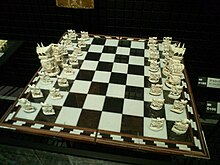This article needs additional citations for verification. (April 2017) |

Chaturanga (Sanskrit: चतुरङ्ग, IAST: caturaṅga, pronounced [tɕɐtuˈɾɐŋɡɐ]) is an ancient Indian strategy board game. It is first known from India around the seventh century AD.[1]
While there is some uncertainty, the prevailing view among chess historians is that chaturanga is the common ancestor of the board games chess, xiangqi (Chinese), janggi (Korean), shogi (Japanese), sittuyin (Burmese), makruk (Thai), ouk chatrang (Cambodian) and modern Indian chess.[1] It was adopted as chatrang (shatranj) in Sassanid Persia, which in turn was the form of chess brought to late-medieval Europe.[2]
Not all the rules of Chaturanga are known with certainty. Chess historians suppose that the game had similar rules to those of its successor, shatranj. In particular, there is uncertainty as to the moves of the gaja (elephant).[3]
- ^ a b Cite error: The named reference
Murraywas invoked but never defined (see the help page). - ^ "World Chess Day 2022: History, Significance And Quotes About The Game". News18. 2022-07-20. Retrieved 2022-12-26.
- ^ "History and Origins of Chess: From India to Persia and Europe". Profolus. 2020-12-26. Retrieved 2022-05-21.